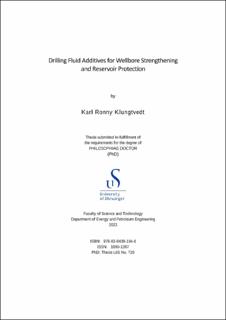| dc.contributor.advisor | Saasen, Arild | |
| dc.contributor.advisor | Khalifeh, Mahmoud | |
| dc.contributor.author | Klungtvedt, Karl Ronny | |
| dc.date.accessioned | 2023-11-09T08:43:55Z | |
| dc.date.available | 2023-11-09T08:43:55Z | |
| dc.date.issued | 2023 | |
| dc.identifier.citation | Drilling Fluid Additives for Wellbore Strengthening and Reservoir Protection by Karl Ronny Klungtvedt, Stavanger : University of Stavanger, 2023 (PhD thesis UiS, no. 726) | en_US |
| dc.identifier.isbn | 978-82-8439-194-6 | |
| dc.identifier.issn | 1890-1387 | |
| dc.identifier.uri | https://hdl.handle.net/11250/3101558 | |
| dc.description.abstract | The objective of the research was to optimise drilling fluid additives for wellbore strengthening, preventing lost circulation and avoiding drilling fluid induced formation damage. Industry standard testing, such as HTHP fluid loss tests following API 13B, yield limited insight into important areas such as wellbore strengthening and formation damage.
Therefore, new testing methodologies were developed and evaluated. These provided new insight into important areas for designing and evaluating drilling fluids and drilling fluid additives for wellbore strengthening and reservoir protection.
Key conclusions were that exposing particles to mechanical wear significantly impacted the relative performance of materials used for preventative treatments.
Oil-based fluids were found to create a high-degree of internal formation plugging, whereas water-based fluids more predominantly isolated the wellbore pressure from the pore-pressure though an external filter-cake. Inclusion of cellulose based fibres where the D90 value value ⪞ 3/2 the median pore size was shown to reduce internal plugging and reduce formation damage, in both water-based fluids and oil-based fluids. Particle degradation studies showed that CaCO3 degraded rapidly for particles > 23 μm and that the most wear resistant particles were selected cellulose-based materials. Combinations of fine CaCO3 and slightly coarser cellulose mixtures were found to be effective for creating low-permeability filter-cakes and preventing formation damage.
For preventative treatment in drilling conditions with large differences between the matrix pore-size and the aperture of natural or induced fractures, a dual mode particle size distribution was found to be effective in both laboratory studies and field applications. In such situations, the fine mode of the PSD provided low filter-cake permeabilities when the particles followed an Andreasen distribution with a packing factor of around 0.08-0.10. Natural and induced fractures were most effectively sealed when granular cellulose particles made up the coarse mode of the PSD and these particles were sized similar to or slightly larger than the fracture aperture. | en_US |
| dc.language.iso | eng | en_US |
| dc.publisher | University of Stavanger | en_US |
| dc.relation.ispartofseries | PhD Theses;726 | |
| dc.relation.haspart | Paper 1: Klungtvedt, K.R., Saasen, A., Vasshus, J.K., Trodal, V.B., Mandal, S.K., Berglind, B. and Khalifeh, M. “The Fundamental Principles and Standard Evaluation for Fluid Loss and Possible Extensions of Test Methodology to Assess Consequences for Formation Damage.” Energies, VOL No. 18 (8), Paper 2252 – MDPI, 2021. (open access) | en_US |
| dc.relation.haspart | Paper 2: Klungtvedt, K.R., Berglind, B., Vasshus, J.K., Khalifeh, M. “Preventing Drilling Fluid Induced Reservoir Formation Damage”, SPE-202187-MS, SPE/IADC Middle East Drilling Technology Conference and Exhibition, 25-27 May 2021. (Not available in the repository due to copyright restrictions) | en_US |
| dc.relation.haspart | Paper 3: Klungtvedt, K.R. and Saasen, A. “A Method for Evaluating Drilling Fluid Induced Permeable Formation Damage”, Journal of Petroleum Science and Engineering. https://doi.org/10.1016/j.petrol.2022.110324. (open access) | en_US |
| dc.relation.haspart | Paper 4: Klungtvedt, K.R. and Saasen, A. “Invasion of CaCO3 particles and polymers in porous formations in presence of fibres”, Journal of Petroleum Science and Engineering 2022. https://doi.org/10.1016/j.petrol.2022.110614 (open access) | en_US |
| dc.relation.haspart | Paper 5: Klungtvedt, K.R. and Saasen, A. “The Role of Particle Size Distribution for Fluid Loss Materials on Formation of Filter-Cakes and Avoiding Formation Damage”. OMAE2022-79501. Journal of Energy Resources Technology 22-1217, 2023. https://doi.org/10.1115/1.4056187 (open access) | en_US |
| dc.relation.haspart | Paper 6: Klungtvedt, K.R. and Saasen, A. “Comparison of Lost Circulation Material Sealing Effectiveness in Water-Based and Oil-Based Drilling Fluids and Under Conditions of Mechanical Shear and High Differential Pressures”. OMAE2022-79502 and Journal of Energy Resources Technology 22-1218, 2022. https://doi.org/10.1115/1.4054653 (open access) | en_US |
| dc.relation.haspart | Paper 7: Klungtvedt, K.R., Pedrosa, C., and Saasen, A. «Measuring Filter-cake Cohesive Strength and Flowability”, Geoenergy Science and Engineering, Volume 221, February 2023, 111298. https://doi.org/10.1016/j.petrol.2022.111298 (open access) | en_US |
| dc.relation.haspart | Paper 8: Klungtvedt, K.R., Vasshus, J.K., Nesheim, G., Scott, P.D. “Managing High Differential Pressures in Fractured Carbonate Reservoir by use of Wellbore Strengthening Material”, OTC-32173-MS, Offshore Technology Conference 2023, Houston, Texas, USA. https://dx.doi.org/10.4043/32173-MS. (Not available in the repository due to copyright restrictions) | en_US |
| dc.relation.haspart | Paper 9: Klungtvedt, K.R., Vasshus, J.K., Saasen, A. “Assessment of induced fracturing and fracture sealing during drilling”, Geoenergy Science and Engineering, Volume 226 (2023) 211816. https://doi.org/10.1016/j.geoen.2023.211816 (open access) | en_US |
| dc.rights | Navngivelse 4.0 Internasjonal | * |
| dc.rights.uri | http://creativecommons.org/licenses/by/4.0/deed.no | * |
| dc.subject | petroleumsteknologi | en_US |
| dc.subject | petroleum engineering | en_US |
| dc.subject | borevæske | en_US |
| dc.title | Drilling Fluid Additives for Wellbore Strengthening and Reservoir Protection | en_US |
| dc.type | Doctoral thesis | en_US |
| dc.rights.holder | © 2023 Karl Ronny Klungtvedt | en_US |
| dc.subject.nsi | VDP::Teknologi: 500::Berg‑ og petroleumsfag: 510::Petroleumsteknologi: 512 | en_US |

